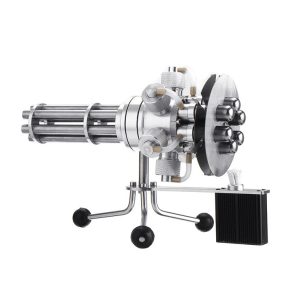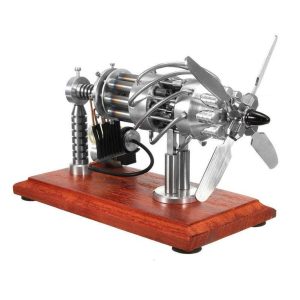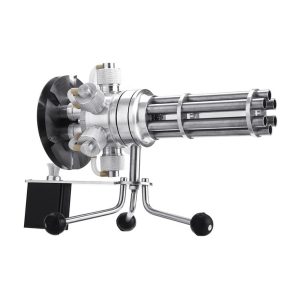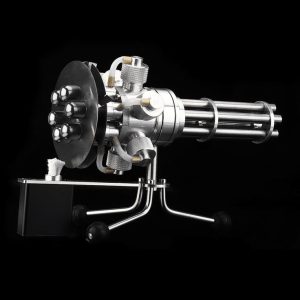Internal combustion engines have dominated the transportation landscape for over a century, powering everything from cars and trucks to motorcycles and lawnmowers. However, there’s another category of engines lurking beneath the surface – the external combustion engine. These engines operate on a different principle, using an external heat source to create the energy that drives the machine.
While not as prevalent as their internal combustion counterparts, external combustion engines play a vital role in various applications. From powering massive electricity grids to generating heat for homes, these versatile engines offer unique advantages that make them irreplaceable in specific situations.

This comprehensive guide dives into the world of external combustion engines, exploring their working principles, different types, applications, and advantages and disadvantages compared to internal combustion engines. By the end, you’ll gain a deeper understanding of this fascinating technology and its role in our world.
Demystifying the External Combustion Engine
At its core, an external combustion engine is a heat engine that converts thermal energy from an external source into mechanical work. Unlike internal combustion engines where fuel is burned directly within the engine itself, external combustion engines rely on a separate heat source, such as burning fossil fuels, solar thermal energy, or nuclear power.
This separation of heat generation and combustion offers several advantages. For instance, it allows for cleaner operation since the combustion process doesn’t occur within the engine itself, potentially reducing emissions. Additionally, external combustion engines can utilize a wider variety of heat sources, making them more fuel-flexible.
Here’s a breakdown of the basic working principle of an external combustion engine:

-
Heat Source: The engine is connected to an external heat source that generates thermal energy. This heat source can be anything from burning fossil fuels in a boiler to concentrated solar thermal energy.
-
Working Fluid: The engine utilizes a working fluid, such as water, air, or a specialized organic liquid. This fluid is circulated within a closed-loop system.
-
Heat Exchanger: The working fluid passes through a heat exchanger where it absorbs thermal energy from the external heat source. This heat causes the working fluid to expand.
-
Expansion and Work: The expanded working fluid pushes against pistons or turbines within the engine, creating mechanical work.
-
Cooling and Compression: Once it has done its job, the working fluid is cooled down in another heat exchanger. This cooling process condenses the fluid back into its original state. The compressed fluid is then circulated back to the first heat exchanger, completing the cycle.
Types of External Combustion Engines
There are several different types of external combustion engines, each with its own unique characteristics and applications. Here’s a closer look at the three most common ones:
-
Steam Engines: These classic engines were the driving force behind the Industrial Revolution. They use water as the working fluid, which is heated to steam in a boiler. The high-pressure steam then pushes against pistons in the engine, generating mechanical power. While largely replaced by more efficient technologies, steam engines are still used in some niche applications today.

-
Stirling Engines: These versatile engines can utilize various heat sources, including solar, biomass, and waste heat. They employ a closed loop system containing a gas, such as helium or hydrogen, as the working fluid. By manipulating the temperature of the gas through hot and cold chambers, the engine creates pressure differentials that drive pistons or turbines. Stirling engines are known for their quiet operation and low emissions.
-
External Combustion Gas Turbines: These powerful engines are commonly used in power plants for electricity generation. They operate similarly to jet engines, using hot combustion gases to spin a turbine that generates electricity. External combustion gas turbines offer high efficiency and can be fueled by natural gas, oil, or even renewable sources like biogas.
Applications of Engines
External combustion engines find application in various sectors, playing a crucial role in our daily lives:
-
Power Generation: Large-scale external combustion engines, primarily gas turbines, are the workhorses of electricity generation. They offer high efficiency and flexibility in terms of fuel sources.
-
Combined Heat and Power (CHP): These systems utilize external combustion engines to generate both electricity and heat. The waste heat from the engine is captured and used for various applications, such as space heating or industrial processes.
-
Transportation: While not as common as internal combustion engines in personal vehicles, external combustion engines have seen some use in transportation, particularly for hybrid and electric vehicles with range extenders. These engines can act as generators, providing additional power to electric motors when needed.
-
Marine Applications: Some ships and submarines utilize external combustion engines, particularly steam turbines, for propulsion.
Advantages and Disadvantages of Engines
External combustion engines offer several advantages compared to their internal combustion counterparts:
-
Cleaner Operation: Since combustion doesn’t occur within the engine itself, external combustion engines have the potential for cleaner emissions. This is because the combustion process can be more controlled, allowing for better management of pollutants.
-
Fuel Flexibility: Many external combustion engines can operate on various heat sources, including renewable sources like solar thermal or biomass. This fuel flexibility makes them less reliant on fossil fuels and more sustainable in the long run.

-
Higher Efficiency: Some types of external combustion engines, like Stirling engines, can achieve higher theoretical efficiencies compared to internal combustion engines. This translates to lower fuel consumption and operating costs.
-
Quieter Operation: External combustion engines generally operate quieter than internal combustion engines due to the separation of combustion and mechanical processes.
However, external combustion engines also come with some disadvantages:
-
Complexity: The design of external combustion engines can be more complex compared to internal combustion engines. This complexity can increase manufacturing costs and maintenance requirements.
-
Power-to-Weight Ratio: External combustion engines often have a lower power-to-weight ratio compared to internal combustion engines. This makes them less suitable for applications where size and weight are critical factors, such as personal vehicles.
-
Warm-up Time: Some external combustion engines require a warm-up period before reaching optimal performance. This can be a drawback in situations where quick response is needed.
The Future of External Combustion Engines
The future of external combustion engines remains uncertain. On the one hand, stricter emission regulations and the push for renewable energy sources could lead to a resurgence of these engines, particularly in applications where electric power isn’t yet feasible. Advancements in materials science and design could also improve the efficiency and power density of external combustion engines, making them more competitive.

On the other hand, the continuous development of battery technology and electric motors could pose a significant challenge to external combustion engines, especially in the transportation sector. The convenience and environmental benefits of electric vehicles could lead to a decline in the use of external combustion engines for personal transportation.
Overall, external combustion engines are likely to remain a niche technology in the transportation sector. However, their potential for clean and efficient power generation, particularly when combined with renewable heat sources, ensures they will continue to play a vital role in various industrial applications for the foreseeable future.
A Spectrum of Power – External Combustion Engines in Our World
External combustion engines represent a fascinating alternative to the internal combustion engines that dominate our roads. While they may not be as ubiquitous, their unique operating principles offer advantages in terms of cleaner emissions, fuel flexibility, and efficiency in specific applications. As we move towards a more sustainable future, external combustion engines could play a crucial role in powering our industries and generating electricity from renewable sources.



